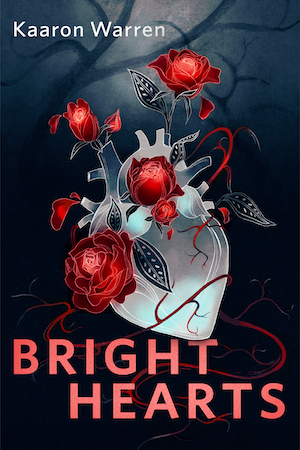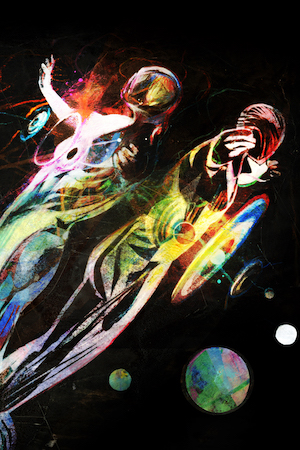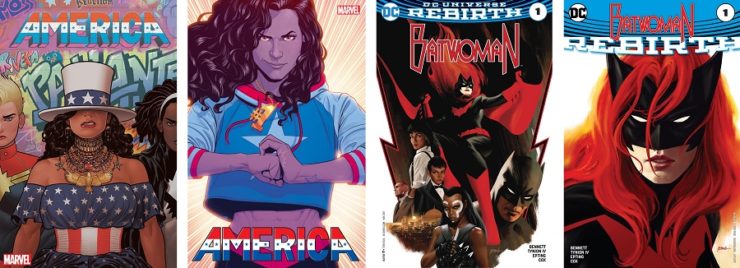It’s March, which means it’s Women’s History Month, and since you’re a comic book geek, you probably want to read some great comics by women creators about women characters. Easier said than done. Indie, web, and alt comics are rife with diversity, representation, and intersectionally feminist stories and creators—special shout outs to Strong Female Protagonist, Qahera, Ladycastle, and Goldie Vance—but sticking to the Big Two is a bigger challenge. Sure, there are a bunch of awesome women superhero comics as well as a bunch of awesome women comics creators, but it isn’t often that both collide on the same Marvel or DC projects.
So imagine my unfiltered glee when I found out that not only is Marguerite Bennett helming the new Batwoman, but also that Gabby Rivera is running America. That’s a queer woman writing a comic about a queer woman vigilante AND a queer Latina writing a comic about a queer Latina superhero. Verily, we live in an exciting age. What a way to celebrate Women’s History Month than with female-created and female-driven stories about awesome women saving the day?
America
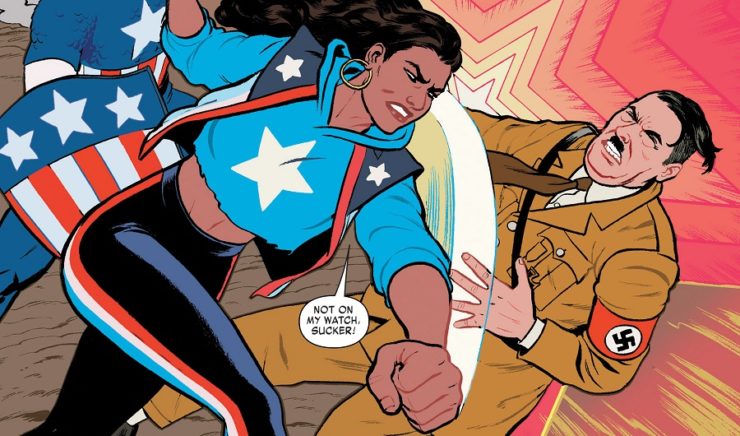
In the past she’s been a Young Avenger and a leader of The Ultimates, but for the first time in her life she’s without a family (her moms died protecting their home universe), without her superpowered teammates, without her bestie (Kate Bishop, aka Hawkeye, is kicking ass and taking names in LA), and without a romantic partner. She has to start from scratch and build a life she wants in whatever way she chooses. The premise itself is rather straightforward—America takes a break from superheroics to go to college—but it’s played with hints of that early-twenties ennui that comes from being unentangled and unencumbered for the first time. The main plot likely has something to do with a mysterious force attacking worlds near her own home parallel universe, but the meat of the story is America divining herself.
I don’t love Joe Quinones’ art, but then again in general I don’t dig his style so it’s more a matter of personal taste than professional critique. I can’t quantify exactly what I dislike about it, but a lot of people love his work so take my distaste with a grain of salt. What Quinones does best here is cast diversity. I adore America’s thick thighs and full brows, the range of ethnicities in the primary and background characters, and literally everything about X’andria and the Leelumultipass Phi Theta Betas. I’m as yet undecided on America’s new costume, but Spectrum’s gets some welcome tweaking. Now if only Quinones could do something about Monica’s hair. Can we all pitch in and send comics artists back to school to learn how to draw Black hair? It’s a major, pervasive problem.
If I had to pick something not-personal to gripe about, it would be the odd penciling and ink work between Quinones, Joe Rivera, and Paolo Rivera. In particular, front-facing noses are faintly sketched with almost no inking whereas mouths and eyes are so heavy handed that they often come off as solid black lines. Otherwise I like the Riveras’ work here; they bring depth to Quinones’ detail. José Villarrubia’s colors are vibrant and vivid, perfect for a bold character like America. Travis Lanham has his work cut out for him with Gabby Rivera’s text. Like a lot of new comics written by traditional fiction writers, Gabby’s script has too much telling and not enough showing. It’s manageable until America shows up at Sotomayor University when the dialogue threatens to overwhelm the story. Lanham does a solid job of preventing that from happening and of minimizing the interruptions to the artwork and panel flow.
America is universal—I mean, who doesn’t want to go back in time and punch Hitler?—but it’s also telling a specific story about what it’s like to be a queer Latina, albeit one from a parallel universe with super strength and who can punch star-shaped holes between dimensions. The short of it is this: if you miss the Miss America from Gillen and McKelvie’s seminal Young Avengers, Gabby Rivera’s America should ease your pain. And in case you didn’t notice, that’s a mostly Latinx creative crew on a Latina book. Yet another reason to add America to your pull list. America is a fantastic #1 and does everything a great premiere issue should: explains the past, explores the present, and sets up the future conflict with exuberance and excitement.
Writer: Gabby Rivera, penciler and cover art: Joe Quinones, inkers: Joe Rivera, Paolo Rivera; colorist: José Villarrubia; letterer and production: Travis Lanham. Marvel published the first issue March 1, 2017.
Batwoman
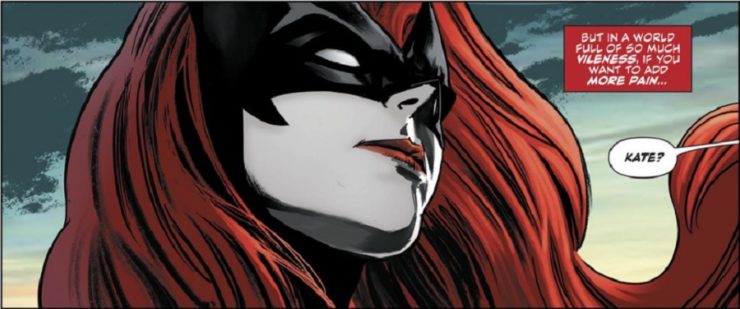
While Batwoman is a relative newcomer to the DC stable (her first official appearance was in 2006, although Kathy Kane debuted fifty years prior), she’s left an indelible mark. She’s one of the bestselling regulars and one of the most beloved. Adding her to any team demonstrably improves it, but she really shines in her solo stuff. The J. H. William III era is the stuff of legends, and Marguerite Bennett and James Tynion IV gives him a run for his money with the latest relaunch.
Like America Chavez, Kate Kane is in a period of transition. She’s survived her past—the horrific murder of her mother and sister, being expelled from the military for violating Don’t Ask Don’t Tell, drug abuse, nearly drowning—and is now building a new life for herself among the wreckage as a vigilante. At present she’s hunting down monster blood with a Pennyworth as her Q, a plot which folds back in with a mysterious assassin and Kate’s ex-girlfriend Safiyah. Figuring out what Batwoman can do that Batman can’t is her raison d’être, and whatever answer she comes up with will set her path for the future. Yet while America is eager to see where she’s going, Kate is more reluctant. She doesn’t necessarily like where she’s at, but also isn’t quite ready to find out where she’ll end up. Life isn’t like a battle where skill and strategy can save the day; fighting is hard, living is harder. Her scattered histories trail behind her but they’re about to catch up with her and force her attention whether she’s ready to give it or not. Kate will never be happy until she comes to an accord with her past, but is happiness even something she wants? Or deserves?
Marguerite Bennett and James Tynion IV are two extremely talented and exceedingly creative writers. They’re playing a long game with Batwoman by building out a story piece by fractured piece. Deron Bennett makes some interesting choices with lettering and text boxes, all of which heighten the uniqueness of each character. Jeromy Cox did standout work on two of my favorite pre-Rebirth titles, Midnighter and Grayson, and continues that quality in Batwoman. Here his colors are rich, bold hues with reddish undertones. Kate’s inner darkness bleeds out onto the page, sometimes literally, and his colors are as shocking as they are lush. Paired with Steve Epting’s stellar and avant-garde panels, the experience is almost breathtaking.
There’s a lot here paying homage to the status quo set by J. H. Williams, but it never feels reductive or repetitive. Both Epting and Quinones really get their leads. Even when shown in revealing clothing or sexual situations, Batwoman and America are never drawn for the male gaze or in objectifying positions. Kate and America are powerful, attractive, intelligent women who know their value and demand respect, and their artists here offer it without hesitation. The art alone is worth the price of admission but coupled with Bennett and Tynion you have no excuse for not reading Batwoman.
Writers: Marguerite Bennett, James Tynion IV; artist and cover art: Steve Epting; colors: Jeromy Cox; letters: Deron Bennett. DC published Rebirth: Batwoman #1 in February 2017, but the official first issue of the new Batwoman series released March 15.
Alex Brown is a teen librarian, writer, geeknerdloserweirdo, and all-around pop culture obsessive who watches entirely too much TV. Keep up with her every move on Twitter and Instagram, or get lost in the rabbit warren of ships and fandoms on her Tumblr.


